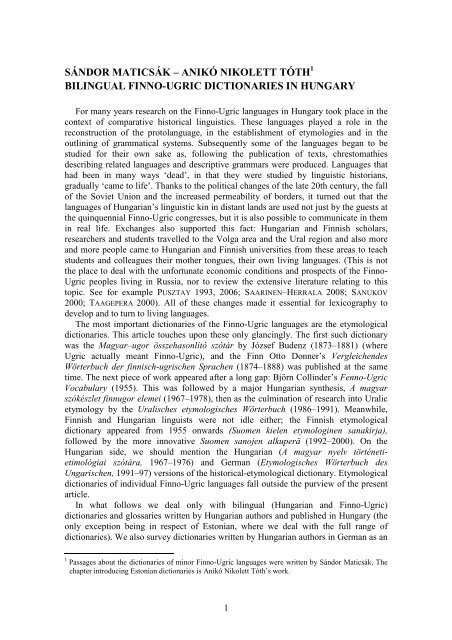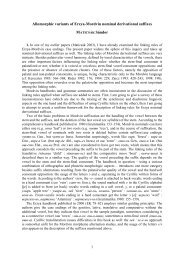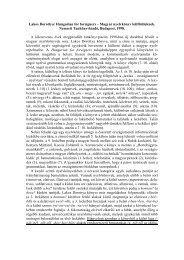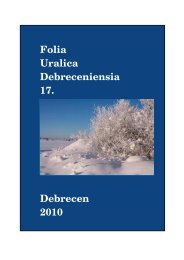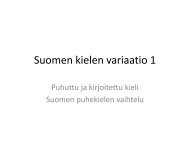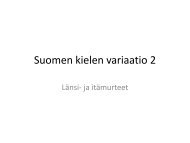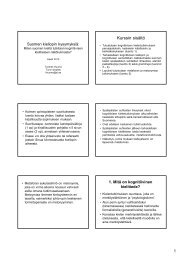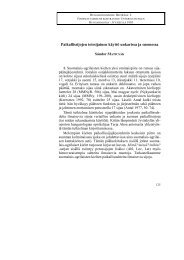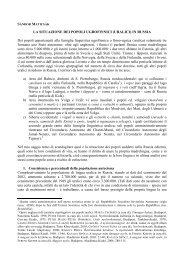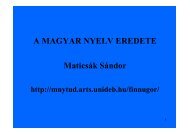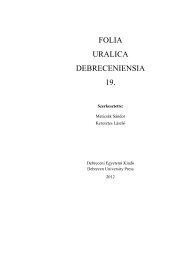Bilingual Finno-Ugric Dictionaries in Hungary. - Finnugor ...
Bilingual Finno-Ugric Dictionaries in Hungary. - Finnugor ...
Bilingual Finno-Ugric Dictionaries in Hungary. - Finnugor ...
Create successful ePaper yourself
Turn your PDF publications into a flip-book with our unique Google optimized e-Paper software.
SÁNDOR MATICSÁK – ANIKÓ NIKOLETT TÓTH 1<br />
BILINGUAL FINNO-UGRIC DICTIONARIES IN HUNGARY<br />
For many years research on the <strong>F<strong>in</strong>no</strong>-<strong>Ugric</strong> languages <strong>in</strong> <strong>Hungary</strong> took place <strong>in</strong> the<br />
context of comparative historical l<strong>in</strong>guistics. These languages played a role <strong>in</strong> the<br />
reconstruction of the protolanguage, <strong>in</strong> the establishment of etymologies and <strong>in</strong> the<br />
outl<strong>in</strong><strong>in</strong>g of grammatical systems. Subsequently some of the languages began to be<br />
studied for their own sake as, follow<strong>in</strong>g the publication of texts, chrestomathies<br />
describ<strong>in</strong>g related languages and descriptive grammars were produced. Languages that<br />
had been <strong>in</strong> many ways ‘dead’, <strong>in</strong> that they were studied by l<strong>in</strong>guistic historians,<br />
gradually ‘came to life’. Thanks to the political changes of the late 20th century, the fall<br />
of the Soviet Union and the <strong>in</strong>creased permeability of borders, it turned out that the<br />
languages of Hungarian’s l<strong>in</strong>guistic k<strong>in</strong> <strong>in</strong> distant lands are used not just by the guests at<br />
the qu<strong>in</strong>quennial <strong>F<strong>in</strong>no</strong>-<strong>Ugric</strong> congresses, but it is also possible to communicate <strong>in</strong> them<br />
<strong>in</strong> real life. Exchanges also supported this fact: Hungarian and F<strong>in</strong>nish scholars,<br />
researchers and students travelled to the Volga area and the Ural region and also more<br />
and more people came to Hungarian and F<strong>in</strong>nish universities from these areas to teach<br />
students and colleagues their mother tongues, their own liv<strong>in</strong>g languages. (This is not<br />
the place to deal with the unfortunate economic conditions and prospects of the <strong>F<strong>in</strong>no</strong>-<br />
<strong>Ugric</strong> peoples liv<strong>in</strong>g <strong>in</strong> Russia, nor to review the extensive literature relat<strong>in</strong>g to this<br />
topic. See for example PUSZTAY 1993, 2006; SAARINEN–HERRALA 2008; SANUKOV<br />
2000; TAAGEPERA 2000). All of these changes made it essential for lexicography to<br />
develop and to turn to liv<strong>in</strong>g languages.<br />
The most important dictionaries of the <strong>F<strong>in</strong>no</strong>-<strong>Ugric</strong> languages are the etymological<br />
dictionaries. This article touches upon these only glanc<strong>in</strong>gly. The first such dictionary<br />
was the Magyar–ugor összehasonlító szótár by József Budenz (1873–1881) (where<br />
<strong>Ugric</strong> actually meant <strong>F<strong>in</strong>no</strong>-<strong>Ugric</strong>), and the F<strong>in</strong>n Otto Donner’s Vergleichendes<br />
Wörterbuch der f<strong>in</strong>nisch-ugrischen Sprachen (1874–1888) was published at the same<br />
time. The next piece of work appeared after a long gap: Björn Coll<strong>in</strong>der’s Fenno-<strong>Ugric</strong><br />
Vocabulary (1955). This was followed by a major Hungarian synthesis, A magyar<br />
szókészlet f<strong>in</strong>nugor elemei (1967–1978), then as the culm<strong>in</strong>ation of research <strong>in</strong>to Uralic<br />
etymology by the Uralisches etymologisches Wörterbuch (1986–1991). Meanwhile,<br />
F<strong>in</strong>nish and Hungarian l<strong>in</strong>guists were not idle either; the F<strong>in</strong>nish etymological<br />
dictionary appeared from 1955 onwards (Suomen kielen etymolog<strong>in</strong>en sanakirja),<br />
followed by the more <strong>in</strong>novative Suomen sanojen alkuperä (1992–2000). On the<br />
Hungarian side, we should mention the Hungarian (A magyar nyelv történetietimológiai<br />
szótára, 1967–1976) and German (Etymologisches Wörterbuch des<br />
Ungarischen, 1991–97) versions of the historical-etymological dictionary. Etymological<br />
dictionaries of <strong>in</strong>dividual <strong>F<strong>in</strong>no</strong>-<strong>Ugric</strong> languages fall outside the purview of the present<br />
article.<br />
In what follows we deal only with bil<strong>in</strong>gual (Hungarian and <strong>F<strong>in</strong>no</strong>-<strong>Ugric</strong>)<br />
dictionaries and glossaries written by Hungarian authors and published <strong>in</strong> <strong>Hungary</strong> (the<br />
only exception be<strong>in</strong>g <strong>in</strong> respect of Estonian, where we deal with the full range of<br />
dictionaries). We also survey dictionaries written by Hungarian authors <strong>in</strong> German as an<br />
1 Passages about the dictionaries of m<strong>in</strong>or <strong>F<strong>in</strong>no</strong>-<strong>Ugric</strong> languages were written by Sándor Maticsák. The<br />
chapter <strong>in</strong>troduc<strong>in</strong>g Estonian dictionaries is Anikó Nikolett Tóth’s work.<br />
1
<strong>in</strong>termediary language, and glossaries published <strong>in</strong> the chrestomathies of <strong>in</strong>dividual<br />
<strong>F<strong>in</strong>no</strong>-<strong>Ugric</strong> languages. Earlier dictionaries satisfied only the needs of historical<br />
l<strong>in</strong>guistics and conta<strong>in</strong> a treasure trove of knowledge collected on research expeditions<br />
at the end of the 19th and the beg<strong>in</strong>n<strong>in</strong>g of the 20th century. More recent dictionaries<br />
are decidedly more communicative and attempt to record the vocabulary of the liv<strong>in</strong>g<br />
language.<br />
Vogul (Mansi) 2<br />
Although János Sajnovics established as early as 1770 that Hungarian and Lapp are<br />
l<strong>in</strong>guistically related (Demonstratio), and Sámuel Gyarmati had described the<br />
relationship of all the <strong>F<strong>in</strong>no</strong>-<strong>Ugric</strong> languages <strong>in</strong> a scholarly manner <strong>in</strong> 1799 (Aff<strong>in</strong>itas),<br />
the Hungarian public, be<strong>in</strong>g <strong>in</strong> the fever of the reform era, and draw<strong>in</strong>g on the memories<br />
of the glorious past, rejected the idea of a “k<strong>in</strong>ship smell<strong>in</strong>g of fish”. Given this social<br />
background, many years had to pass before a survey of the languages and lives of the<br />
Hungarians’ k<strong>in</strong> could beg<strong>in</strong>. The first to realize that one of the priorities for l<strong>in</strong>guists<br />
was research on the Ob-<strong>Ugric</strong> languages was Antal Reguly. He reached the Hungarians’<br />
l<strong>in</strong>guistic k<strong>in</strong> <strong>in</strong> Siberia <strong>in</strong> 1843 and spent a year and a half there collect<strong>in</strong>g unique<br />
material, but his early death unfortunately prevented him from publish<strong>in</strong>g it. A<br />
prom<strong>in</strong>ent figure of the second generation of <strong>F<strong>in</strong>no</strong>-<strong>Ugric</strong> l<strong>in</strong>guists was Bernát<br />
Munkácsi, who collected a great deal of l<strong>in</strong>guistic and ethnographic material on his<br />
journeys to the Voguls and Votyaks (1888–1889), thanks to which he succeeded <strong>in</strong><br />
<strong>in</strong>terpret<strong>in</strong>g most of Reguly’s texts. He was able to publish several works as a result of<br />
his own Vogul fieldwork (MUNKÁCSI 1892–1921; 1894; MUNKÁCSI–KÁLMÁN 1952,<br />
1963). The vocabulary of the first three volumes of the Vogul népköltési gyűjtemény<br />
was compiled by Móric SZILASI (1895), of the fourth volume by Zoltán TRÓCSÁNYI<br />
(1909). Szilasi’s words <strong>in</strong> 1895 proved prophetic: “It will be a long time, alas, before<br />
we can possess a complete Vogul dictionary.” However, even he could not have<br />
imag<strong>in</strong>ed that we would have to wait n<strong>in</strong>e decades for it. (On Munkácsi’s life, see<br />
KÁLMÁN 1981.)<br />
The task of compil<strong>in</strong>g this dictionary devolved on Béla Kálmán, professor of <strong>F<strong>in</strong>no</strong>-<br />
<strong>Ugric</strong> studies at Debrecen’s Kossuth Lajos University, who completed this task with the<br />
assistance of Magda A. Kövesi, László Keresztes and Antal Kiss (MUNKÁCSI–KÁLMÁN<br />
1986). The name of Béla Kálmán is familiar to the educated Hungarian read<strong>in</strong>g public<br />
ma<strong>in</strong>ly because of his excellent popular work on onomastics, A nevek világa, but his<br />
fieldwork on Hungarian dialects is also well-known. As a <strong>F<strong>in</strong>no</strong>-<strong>Ugric</strong> scholar he was<br />
an expert on Vogul; besides a number of essays, he produced Chrestomathia Vogulica<br />
(of which the 20-page glossary was for a long time the only aid for Hungarian <strong>F<strong>in</strong>no</strong>-<br />
Ugrists learn<strong>in</strong>g Vogul). Béla Kálmán edited Munkácsi’s material and although it was<br />
already accessible to scholars <strong>in</strong> the 1960s, the dictionary itself was not published until<br />
1986.<br />
Kálmán writes <strong>in</strong> the preface of his dictionary as follows: “As it appears now, almost<br />
a hundred years after the fieldwork, this work should be seen rather as a historicaldialectal<br />
dictionary of Vogul <strong>in</strong> as it was <strong>in</strong> the late 19th century.” This is true, but as<br />
2 In this paper, we use the traditional names of <strong>F<strong>in</strong>no</strong>-<strong>Ugric</strong> peoples, those which are better-known to the<br />
Hungarian general public.<br />
2
Vogul is studied only at universities, primarily by <strong>F<strong>in</strong>no</strong>-<strong>Ugric</strong> and secondly by<br />
Hungarian majors, it is not surpris<strong>in</strong>g. The dictionary is for scholarly use (the mean<strong>in</strong>g<br />
of the words is given <strong>in</strong> Hungarian and German) and presents difficulties for the<br />
outsider even <strong>in</strong> terms of just read<strong>in</strong>g the data, with all its diacritics and <strong>in</strong> locat<strong>in</strong>g the<br />
entries attested from several different dialects; and the vast number of examples and<br />
citations from Munkácsi’s collection can also deter users unaccustomed to such material<br />
(the Hungarian and German word <strong>in</strong>dex is <strong>in</strong>dispensable). For the professional,<br />
however, this dictionary is extremely useful: it conta<strong>in</strong>s a great deal of <strong>in</strong>formation<br />
about the vocabulary of the Vogul dialects which are rather distant from one another.<br />
Leaf<strong>in</strong>g through the pages of the dictionary, the everyday life of Hungarians’ fish<strong>in</strong>g<br />
and hunt<strong>in</strong>g k<strong>in</strong>smen liv<strong>in</strong>g <strong>in</strong> difficult circumstances comes to life (mår ‘arrow without<br />
a metal tip’, pajp-kwoľ ‘handle of a birch-bark butt’), together with their beliefs (ujkēńśėltaχtė<br />
ēriγ ‘bear-wak<strong>in</strong>g song’, mårakä ‘wife of the water pr<strong>in</strong>ce’). The core<br />
vocabulary also demonstrates the close k<strong>in</strong>ship of Vogul and Hungarian: Vogul kit ~<br />
Hungarian két ‘two’, χūrėm ~ három ‘three’, säm ~ szem ‘eye’ etc.<br />
Ostyak (Khanty)<br />
The Hungarian lexicography of the other Ob-<strong>Ugric</strong> language consists ma<strong>in</strong>ly of<br />
glossaries. <strong>Bil<strong>in</strong>gual</strong> dictionaries are lack<strong>in</strong>g, perhaps partly because it was PAASONEN<br />
(1926) and KARJALAINEN (1948), and then the German STEINITZ (1966–1975), who<br />
provided syntheses <strong>in</strong> their time. The first of the Hungarian glossaries was Bernát<br />
MUNKÁCSI’s Ostyak glossary. In this, he published the material collected by Károly<br />
Pápai, his colleague who died young. Pápai visited the Ostyaks <strong>in</strong> 1888, but he did not<br />
have the opportunity to publish his material, so this task fell to his mentor. The<br />
experienced l<strong>in</strong>guist edited the ethnographer Pápai’s data and complemented it with<br />
Castrén’s and Ahlqvist’s relevant material, then added Pápai’s Russian entries giv<strong>in</strong>g<br />
the mean<strong>in</strong>gs of words with their Hungarian equivalents.<br />
This glossary was followed by Ödön Beke’s Northern Ostyak material (BEKE 1907–<br />
1908). It was back <strong>in</strong> 1898–99 that József Pápay visited the Ostyaks on an expedition<br />
organized by Count Zichy. It took a long time to publish his materials: the texts were<br />
edited by Edit Vértes. (For more <strong>in</strong>formation about Pápay, see KISSNÉ RUSVAI 2010).<br />
His Northern Ostyak glossary was edited by Ödön BEKE (1959).<br />
More recent glossaries are associated with the name of the outstand<strong>in</strong>g Ostyakologist<br />
László Honti. His Northern (HONTI 1978a) and Surgut (HONTI 1978b) material appeared<br />
<strong>in</strong> the journal Nyelvtudományi Közlemények. The former is an approximately 280-word<br />
collection of songs and riddles recorded from four <strong>in</strong>formants from Kazym; the latter is<br />
a 16-page wordlist conta<strong>in</strong><strong>in</strong>g the material collected <strong>in</strong> Tromagan and Pim while the<br />
author studied <strong>in</strong> Len<strong>in</strong>grad.<br />
It was also Honti who published a Northern Ostyak glossary four years later, edited<br />
from three 19th century dictionaries <strong>in</strong> manuscript: those of Popov, Roslyakov and<br />
Bartenev (HONTI 1982). This is an exemplarily thorough piece of scholarship; it<br />
conta<strong>in</strong>s 1706 items and the mean<strong>in</strong>gs of the illustrative sentences and words are given<br />
<strong>in</strong> German. Béla Kálmán estimated that over 10 per cent of the material <strong>in</strong> these<br />
glossaries had not appeared <strong>in</strong> any earlier source (KÁLMÁN 1983: 465).<br />
Another essential work by László Honti was the gap-fill<strong>in</strong>g handbook Chrestomathia<br />
Ostiacica published <strong>in</strong> 1984. Its glossary of nearly two thousand words, represent<strong>in</strong>g the<br />
3
texts <strong>in</strong> the volume, is given <strong>in</strong> a simplified, somewhat more “user-friendly”<br />
transcription. The other chrestomathy featur<strong>in</strong>g a glossary of the Northern dialect is<br />
structured similarly (SZ. KISPÁL–MÉSZÁROS 1980). The transcription employed <strong>in</strong> the<br />
latter is difficult to read: the extensive use of diacritics is problematic even for<br />
university students.<br />
Zyrian (Komi)<br />
An outstand<strong>in</strong>g achievement of Zyrian lexicography is Dávid FOKOS-FUCHS’s<br />
dictionary (1959). Only two comparable works were available before this:<br />
WIEDEMANN’s work from 1880 and a dictionary by WICHMANN and UOTILA from 1942.<br />
Like that of many other such works, the publication of this one, too, came decades after<br />
the collection of the materials: Fokos had collected texts as early as 1911 and 1913,<br />
dur<strong>in</strong>g his study trips; and later, <strong>in</strong> the years 1916–17 he also recorded some valuable<br />
l<strong>in</strong>guistic <strong>in</strong>formation from Zyrian prisoners of war (as did Beke, from Cheremis ones;<br />
see below). The dictionary of 7,000 entries (22,000 words altogether) is someth<strong>in</strong>g of a<br />
cross between an essential tool for <strong>F<strong>in</strong>no</strong>-Ugrists and a vocabulary of the liv<strong>in</strong>g<br />
language. The former feature is illustrated by the fact that etymologically related words<br />
are shown with<strong>in</strong> the same entry; the latter characteristic appears <strong>in</strong> the rich hoard of<br />
example sentences and expressions that aim to clarify the different shades of mean<strong>in</strong>g.<br />
Fokos provides multiple <strong>in</strong>flected forms for nouns and verbs, which helps with the<br />
morphological features of the stems. This dictionary is an important source for Zyrian<br />
word-formation, thanks to the large number of compounds and derived words <strong>in</strong> it. A<br />
po<strong>in</strong>t of <strong>in</strong>terest is the fact that Fokos <strong>in</strong>cludes and duly identifies many Russian loans.<br />
(For an evaluation of the dictionary, see RÉDEI 1960).<br />
The outstand<strong>in</strong>g scholar of Permic Károly RÉDEI published F. A. Volegov’s<br />
vocabulary material from 1833 <strong>in</strong> 1968. Volegov was the head of the salt m<strong>in</strong>e <strong>in</strong><br />
Usolye and he gave a copy of his own Permyak material to Reguly as a gift. (Permyak<br />
is one of the major dialects of the Zyrian language; Russian researchers consider it to be<br />
a language <strong>in</strong> its own right.) This material had been gather<strong>in</strong>g dust <strong>in</strong> the manuscript<br />
rooms of the Hungarian Academy of Sciences until Rédei published it. The entries of<br />
this approximately 4000-word glossary <strong>in</strong> Cyrillic characters are a valuable source for<br />
both l<strong>in</strong>guists and ethnographers. The entries are followed by the Russian mean<strong>in</strong>g, then<br />
the transcription of the Permyak word <strong>in</strong>to Lat<strong>in</strong> characters, together with the mean<strong>in</strong>g<br />
<strong>in</strong> German. The volume also has a Russian word <strong>in</strong>dex.<br />
Another of Károly Rédei’s publications is his Chrestomathia Syrjaenica (RÉDEI<br />
1978). This conta<strong>in</strong>s a 31-page glossary, which is an <strong>in</strong>dispensable aid for university<br />
students learn<strong>in</strong>g Zyrian.<br />
The head of a university department <strong>in</strong> Szombathely, János Pusztay, has published<br />
several dictionaries as part of his many series of publications. Between 1993 and 2003<br />
ten pocket dictionaries, practical and useful, appeared <strong>in</strong> his Hungarian Centre for<br />
<strong>F<strong>in</strong>no</strong>-<strong>Ugric</strong> Lexicography (three of Estonian, two of Mordv<strong>in</strong>ian and one each of<br />
Zyrian, Votyak, Cheremis, Nenets and Latvian). The seventh volume of this series is the<br />
Zyrian–Hungarian dictionary of Nikolay Kuznetsov, a l<strong>in</strong>guist with excellent Hungarian<br />
active knowledge <strong>in</strong> Estonia (KUZNETSOV 2003). The 171-page dictionary gives the<br />
entries <strong>in</strong> Cyrillic letters. The structure of the dictionary is clear, with mean<strong>in</strong>gs and<br />
homonyms clearly separated, and many expressions to help learn the liv<strong>in</strong>g language. It<br />
4
is a pity that it does not conta<strong>in</strong> more entries. There is an appendix, Rövid komi nyelvtan<br />
(‘A Brief Grammar of Komi’), by the series editor János Pusztay, giv<strong>in</strong>g the essentials<br />
of Zyrian grammar, from phonological issues through the long established<br />
morphological categories to syntactic notes. This is a very useful addendum, which<br />
makes the work of the language learner much easier. (The other volumes <strong>in</strong> the series<br />
also conta<strong>in</strong> such summaries.)<br />
Votyak (Udmurt)<br />
We owe the first scholarly glossary of Votyak to WIEDEMANN (1880), <strong>in</strong> an appendix<br />
to his Zyrian–German dictionary, but this 40-page list is of limited value both <strong>in</strong> terms<br />
of phonetic notation and its arrangement of dialects. Hence Bernát Munkácsi, who has<br />
already been mentioned <strong>in</strong> connection with Vogul lexicography, wrote the follow<strong>in</strong>g<br />
about his 1885 field trip to the Kama area (one of the results of which was his extensive<br />
Votják népköltészeti hagyományok): “My greatest concern besides collect<strong>in</strong>g texts was<br />
to re-exam<strong>in</strong>e the vocabulary of [Wiedemann’s] Votyak dictionary and to expand its<br />
material as much as possible” (MUNKÁCSI 1896a: VI). Munkácsi strove for philological<br />
accuracy; he <strong>in</strong>dicated the dialect area, the irregular (and perhaps unreliable) forms and<br />
the derivation of each word. His procedure <strong>in</strong> giv<strong>in</strong>g the mean<strong>in</strong>gs is exemplary, as<br />
besides the Hungarian and German equivalents of the words he also provides<br />
explanations <strong>in</strong> Russian or Tatar: “I considered the most important prerequisite of the<br />
critical method to <strong>in</strong>clude as accurately as possible those orig<strong>in</strong>al Russian or Tatar<br />
explanations of the words which were provided by my <strong>in</strong>formants as they tried to<br />
describe the mean<strong>in</strong>gs of expressions for me” (MUNKÁCSI 1896a: XVIII). Another of<br />
Munkácsi’s goals was to collect ethnographical material and this is why he tries to<br />
def<strong>in</strong>e or expla<strong>in</strong> words that fall with<strong>in</strong> the scope of mythology and folklore tradition;<br />
see for example the description of the summer and w<strong>in</strong>ter solstice (<strong>in</strong>vožo-dir, 53) or the<br />
detailed def<strong>in</strong>ition of the “domestic ghost” (Voršud, 683). Thanks to his carefulness, this<br />
volum<strong>in</strong>ous work (818 pages <strong>in</strong>clud<strong>in</strong>g the German <strong>in</strong>dex) is still, after more than a<br />
century, an <strong>in</strong>dispensable aid for Votyak scholars. The dictionary was repr<strong>in</strong>ted by<br />
János Pusztay <strong>in</strong> 1990.<br />
After the publication of Munkácsi’s dictionary there was little lexicographical<br />
activity <strong>in</strong> Votyak for a long time. The noted Permic scholar Yrjö Wichmann’s<br />
comprehensive dictionary, which was the result of his late 19th century field trip,<br />
appeared only <strong>in</strong> 1987 (WICHMANN 1987). Of the series of <strong>F<strong>in</strong>no</strong>-<strong>Ugric</strong> chrestomathies<br />
published <strong>in</strong> <strong>Hungary</strong>, that devoted to Votyak was the work of Sándor CSÚCS (1990).<br />
The 32-page glossary of this work has proved very serviceable <strong>in</strong> the tra<strong>in</strong><strong>in</strong>g of<br />
university students.<br />
In the last decade, István Kozmács has made a concerted effort to familiarize<br />
Hungarians with the liv<strong>in</strong>g Votyak language. His course book (KOZMÁCS 1998) was<br />
published before the turn of the millennium; this has a short Votyak–Hungarian and<br />
Hungarian–Votyak glossary. His Votyak–Hungarian dictionary came out <strong>in</strong> the Lexica<br />
Savariensia series <strong>in</strong> 2002 (KOZMÁCS 2002). This extensive work (almost 500 pages)<br />
conta<strong>in</strong>s the corpus of earlier dictionaries on the one hand (<strong>in</strong> addition to Munkácsi and<br />
Wichmann also F<strong>in</strong>nish and Russian works), and material about today’s liv<strong>in</strong>g Votyak<br />
language (ma<strong>in</strong>ly media and imag<strong>in</strong>ative literature) on the other. Kozmács <strong>in</strong>troduces an<br />
important <strong>in</strong>novation which <strong>in</strong>dicates some emphasis on the liv<strong>in</strong>g nature of the<br />
5
language: he <strong>in</strong>cludes neologisms, mark<strong>in</strong>g them with the abbreviation nyúj, e.g.<br />
йыгдон ‘greenhouse’, кун ужчи ‘statesman’. However, the dictionary also conta<strong>in</strong>s<br />
much dialect material. The traditional sphere is also well represented: гербер ‘holiday<br />
after spr<strong>in</strong>g plough<strong>in</strong>g and before reap<strong>in</strong>g’, куккем ‘bride kidnapp<strong>in</strong>g’, мамаля ‘table<br />
service for pagan sacrificial rites’ etc. As these are a people liv<strong>in</strong>g close to nature it is<br />
appropriate that he <strong>in</strong>cludes many plant and animal names, such as those for the<br />
common hedge hyssop, the common tern, or the red-breasted flycatcher. At the end of<br />
the dictionary there is a well-organized 26-page grammatical conspectus of Votyak<br />
grammar, with illustrative tables and many useful sentences and expressions.<br />
Cheremis (Mari)<br />
The above-mentioned Antal Reguly, after his expedition to Siberia, also carried out<br />
research <strong>in</strong> the Volga area. At the request of the Hungarian Academy of Sciences he<br />
travelled to the land of the Cheremis, the Mordv<strong>in</strong>s and the Chuvash <strong>in</strong> 1845. His severe<br />
illness and early death prevented him from arrang<strong>in</strong>g and publish<strong>in</strong>g his material, so this<br />
was left to succeed<strong>in</strong>g generations. The Vogul and Ostyak material was edited by<br />
Hunfalvy, while József Budenz was entrusted with publish<strong>in</strong>g his Cheremis data. The<br />
latter published this rich material (876 sample sentences and two sermons) <strong>in</strong> 1864, <strong>in</strong><br />
Nyelvtudományi Közlemények, and then used it as the basis for a Cheremis grammar.<br />
His 3,000-word vocabulary list first appeared <strong>in</strong> Nyelvtudományi Közlemények (BUDENZ<br />
1865a), then also as a separate publication (BUDENZ 1865b). In fact, the dictionary is<br />
tril<strong>in</strong>gual, because the Lat<strong>in</strong> equivalent of each word is given as well as the Hungarian.<br />
Verbs are listed <strong>in</strong> the first person s<strong>in</strong>gular – due to morphological considerations – and<br />
a few derived words are given <strong>in</strong> the entry of the base word. Budenz also pays special<br />
attention to the orig<strong>in</strong> of the vocabulary, and also <strong>in</strong>dicates the Tatar or Russian orig<strong>in</strong><br />
of certa<strong>in</strong> words: “I made a separate list of words of Russian orig<strong>in</strong>, which are not<br />
relevant from the po<strong>in</strong>t of view of Altaic l<strong>in</strong>guistics; there are many of these, especially<br />
<strong>in</strong> the Bible translation and often without any need for them.” (BUDENZ 1865: 334).<br />
Some decades later, Móric SZILASI also published a Cheremis dictionary. His work<br />
of 6,800 entries first appeared <strong>in</strong> Nyelvtudományi Közlemények <strong>in</strong> several <strong>in</strong>stalments<br />
(1898–1900) and then it was also published <strong>in</strong> a separate volume (1901). His dictionary<br />
is twice the size of that of Budenz, for he also used the material collected by F<strong>in</strong>nish<br />
researchers (Arvid Genetz and Volmari Porkka) and the corpus of Troickii’s Cheremis–<br />
Russian dictionary, published <strong>in</strong> Kazan <strong>in</strong> 1894.<br />
In the fertile period of the “heroic age”, few could have imag<strong>in</strong>ed that it would take<br />
decades for the next dictionary of Cheremis to appear. At the time of World War I,<br />
Ödön Beke, an outstand<strong>in</strong>g Hungarian scholar of Cheremis, was entrusted by the<br />
Hungarian Academy of Sciences with collect<strong>in</strong>g as much valuable material as possible<br />
from Cheremis prisoners of war. The songs, proverbs, tales and spells recorded from 29<br />
<strong>in</strong>formants from n<strong>in</strong>e dialect areas rema<strong>in</strong>ed <strong>in</strong> manuscript for a long time and only after<br />
the cataclysm of World War II were they published, between 1951 and 1961 (for<br />
detailed bibliographical data, see VELENYÁK 1963). Furthermore, the second volume<br />
had been ly<strong>in</strong>g among the unpublished dictionary material and slips for decades, and<br />
was only published <strong>in</strong> 1995, thanks to the good offices of János Pusztay (BEKE 1995).<br />
The publication of Beke’s dictionary material proved even more difficult. Try<strong>in</strong>g to<br />
publish this immense quantity of dialectal material had for decades been just a pipe-<br />
6
dream, until – 33 years after Beke’s death – Gábor Bereczki, an outstand<strong>in</strong>g <strong>F<strong>in</strong>no</strong>-<br />
<strong>Ugric</strong> scholar and Margarita Kuznetsova, a Cheremis l<strong>in</strong>guist liv<strong>in</strong>g <strong>in</strong> <strong>Hungary</strong>,<br />
undertook the edit<strong>in</strong>g of this huge corpus. As a result of their labours, the dialect<br />
dictionary of some 3,332 pages, <strong>in</strong> n<strong>in</strong>e volumes, came out <strong>in</strong> János Pusztay’s<br />
Bibliotheca Ceremissica series around the turn of the millennium (BEKE 1997–2001). In<br />
his evaluation of this work Gábor Zaicz wrote (ZAICZ 2002: 161): “I th<strong>in</strong>k that both the<br />
conceptual-methodological framework and the practical solutions of the dictionary are<br />
to be commended; the entry-words are easy to locate, and the entries themselves are<br />
also clearly structured.” The entries follow the pr<strong>in</strong>ciple of etymological arrangement;<br />
they conta<strong>in</strong> the various dialect variations and a substantial number of illustrative<br />
sentences also. This work is therefore a priceless resource for Cheremis historical<br />
l<strong>in</strong>guistics and dialectology.<br />
Gábor Bereczki also wrote a course book very much appreciated <strong>in</strong> university<br />
tra<strong>in</strong><strong>in</strong>g (BERECZKI 1990). The lucidly structured, clearly transcribed and easy-to-use<br />
glossary of his chrestomathy (99–123) has been aid<strong>in</strong>g students learn<strong>in</strong>g Cheremis for<br />
two decades now.<br />
It was also Margarita Kuznetsova who ensured that the everyday variety of Cheremis<br />
be made accessible to those who were <strong>in</strong>terested. Her easy-to-use and practical<br />
dictionary appeared as the n<strong>in</strong>th volume <strong>in</strong> the above-mentioned valuable Szombathely<br />
series, the Lexica Savariensia (KUZNETSOVA 2003).<br />
Mordv<strong>in</strong>ian (Erzya, Moksha)<br />
Mordv<strong>in</strong>ian is a language with an almost unmatched lexicographical past and<br />
present. Antal Reguly visited the land of the Mordv<strong>in</strong> people between 1843 and 1846<br />
and his collection (tales and songs) together with his glossary – complemented with<br />
Ahlqvist’s and Wiedemann’s material – was published by József BUDENZ <strong>in</strong> 1866<br />
(BUDENZ 1866). The 86-page glossary gives Moksha entry-words followed by the Erzya<br />
forms (it is a peculiarity of the glossary that Budenz gives verbs <strong>in</strong> the first person<br />
s<strong>in</strong>gular form, due to morphological considerations). He does not <strong>in</strong>clude words of<br />
Russian orig<strong>in</strong>.<br />
Jenő Juhász began to collect material from the Moksha dialect “from course books,<br />
literary texts, newspapers and scientific booklets” <strong>in</strong> 1926. He cont<strong>in</strong>ued his fieldwork<br />
<strong>in</strong> the prisoner-of-war camp <strong>in</strong> Nastola, F<strong>in</strong>land <strong>in</strong> 1942, where he worked with four<br />
Moksha prisoners of war. Follow<strong>in</strong>g his death <strong>in</strong> 1960, the edit<strong>in</strong>g of the material was<br />
taken over by István Erdélyi, and the book f<strong>in</strong>ally came out the follow<strong>in</strong>g year<br />
(JUHÁSZ–ERDÉLYI 1961). The 183-page dictionary conta<strong>in</strong>s the vocabulary of four<br />
Moksha dialects. To use it, one needs some l<strong>in</strong>guistic background, as the transcription<br />
<strong>in</strong> the dictionary is difficult (it still conta<strong>in</strong>s the reduced velar, palatalized k and f etc.)<br />
The dictionary-user’s work is eased by a Hungarian <strong>in</strong>dex. Ow<strong>in</strong>g to its relatively<br />
limited vocabulary, its difficulty of use and the m<strong>in</strong>or role of Moksha <strong>in</strong> Hungarian<br />
higher education, this dictionary was not widely used.<br />
The next Mordv<strong>in</strong>ian lexicographical work is an Erzya glossary (ERDŐDI–ZAICZ<br />
1974). This 106-page list of some 1,300 words, orig<strong>in</strong>ally prepared for ERDŐDI’s<br />
chrestomathy (1968), <strong>in</strong> fact encompasses the core vocabulary of Mordv<strong>in</strong>ian. After<br />
each entry the authors provide both derived and compounded forms <strong>in</strong> an etymological<br />
arrangement. As the structure of the dictionary is lucid and the transcription used is<br />
7
straightforward, it played an important role <strong>in</strong> university tra<strong>in</strong><strong>in</strong>g until the late 1980s,<br />
when it was superseded by László KERESZTES’s chrestomathy (1990), the 1,700-word<br />
glossary of which conta<strong>in</strong>s the vocabulary of all the texts and read<strong>in</strong>gs of the book, both<br />
Erzya and Moksha (e.g. kud M, kudo E ‘house’; kši E, M ‘bread’ etc.) The chrestomathy<br />
– together with the glossary – played an important role <strong>in</strong> the tra<strong>in</strong><strong>in</strong>g of <strong>F<strong>in</strong>no</strong>-<strong>Ugric</strong><br />
majors for a long time.<br />
Mordv<strong>in</strong> lexicography’s new golden age <strong>in</strong> Mordovia, F<strong>in</strong>land and <strong>Hungary</strong> alike<br />
occurred <strong>in</strong> the 1990s; comprehensive dictionaries, etymological and phraseological<br />
dictionaries, course books and conversational pocket guides mushroomed at this time<br />
(for details, see MATICSÁK 1996). The most prom<strong>in</strong>ent representative figure of<br />
Mordv<strong>in</strong>ian lexicography <strong>in</strong> <strong>Hungary</strong> is Edit Mészáros. Her Erzya–Mordv<strong>in</strong>ian course<br />
book – which is well-structured, conta<strong>in</strong><strong>in</strong>g a 3,000-word Erzya–Hungarian,<br />
Hungarian–Erzya word <strong>in</strong>dex – is still an important aid for <strong>F<strong>in</strong>no</strong>-<strong>Ugric</strong> majors<br />
(MÉSZÁROS 1998). Her Erzya–Hungarian dictionary, co-authored with Raisa<br />
Shirmank<strong>in</strong>a, appeared <strong>in</strong> 1999, with a revised and expanded edition four years later <strong>in</strong><br />
the above-mentioned Szombathely series (MÉSZÁROS–SHIRMANKINA 1999, 2003). In<br />
this work Mordv<strong>in</strong>ian is not a “dead” language, used only <strong>in</strong> university tra<strong>in</strong><strong>in</strong>g as a<br />
matter of special <strong>in</strong>terest, but a liv<strong>in</strong>g one. Their edit<strong>in</strong>g pr<strong>in</strong>ciples are highly<br />
commendable: “In compil<strong>in</strong>g this dictionary, we aim to provide not only the frequently<br />
used vocabulary of the language, but to <strong>in</strong>clude also as many rarer words of ancient<br />
orig<strong>in</strong> as possible; at the same time, we have given only those words of Russian orig<strong>in</strong><br />
that occur most frequently <strong>in</strong> core vocabulary, or that were adopted <strong>in</strong> a modified<br />
phonetic form” (p. 5). It is greatly to the credit of the editors that this dictionary consists<br />
not just of a mechanical set of entry-words and mean<strong>in</strong>gs, but also of many expressions<br />
and colloquial terms. The dictionary is also rich <strong>in</strong> scientific term<strong>in</strong>ology, especially<br />
from the fields of botany, zoology and l<strong>in</strong>guistics. A wealth of expressions referr<strong>in</strong>g to<br />
everyday life and folk customs <strong>in</strong> the Volga area were also <strong>in</strong>cluded, e.g. kuŕńik<br />
‘wedd<strong>in</strong>g pirog (large pie filled with vegetables or meat)’, onava ‘wedd<strong>in</strong>g kibitka<br />
(covered sledge used to carry the bride)’, peŕťim ‘Erzya woman’s tiara’, pulaj ‘Erzya<br />
back apron’, suzma ‘thick, sour milk, stra<strong>in</strong>ed through a l<strong>in</strong>en cloth, similar to cottage<br />
cheese’, tauśa ‘Christmas folk song’.<br />
The dictionary tries to solve the difficult problems of the transcription of <strong>F<strong>in</strong>no</strong>-<br />
<strong>Ugric</strong> languages <strong>in</strong> two ways. The 1998 edition gives the Erzya entry-words <strong>in</strong> Lat<strong>in</strong><br />
letters, the 2003 edition <strong>in</strong> Cyrillic. Both solutions are, to a degree, justified (for details<br />
of the dictionary, see MATICSÁK 1996; ZAICZ 2007).<br />
With Edit Mészáros at their head, a five-member editorial team recently published<br />
the first Hungarian–Erzya–Mordv<strong>in</strong>ian concise dictionary (MÉSZÁROS et al. 2008). The<br />
985-page dictionary conta<strong>in</strong>s about 17,000 entries, but altogether it comprises some<br />
38,000 Hungarian words and expressions. The Erzya equivalents are shown <strong>in</strong> both<br />
Cyrillic and Lat<strong>in</strong> transcription, which is very useful to students and scholars (even<br />
forms aris<strong>in</strong>g out of the uncerta<strong>in</strong> nature of Erzya orthography are <strong>in</strong>cluded at some<br />
po<strong>in</strong>ts).<br />
The vocabulary of the dictionary is up-to-date, meet<strong>in</strong>g even the requirements of<br />
comprehensive dictionaries of world languages. (The headwords <strong>in</strong>clude computer,<br />
mobile phone, <strong>in</strong>ternet, cable, network and e-mail, for example.) There are many<br />
phraseological units <strong>in</strong> the entries and also a satisfy<strong>in</strong>g amount of collocations and<br />
grammatical arguments. Substantial special term<strong>in</strong>ology is also <strong>in</strong>cluded, from medical<br />
8
terms through botany and zoology to sport. It would perhaps have been good to have the<br />
conjugation/declension for Hungarian words, or at least to have a guide show<strong>in</strong>g<br />
<strong>in</strong>flection at the end of the dictionary.<br />
A whole series of Erzya equivalents are to be found next to the <strong>in</strong>dividual Hungarian<br />
words, so that this dictionary is <strong>in</strong> a way also a dictionary of Erzya synonyms; e.g. süt<br />
(= bakes) ‘ŕestams, žaŕams, pańems, valdomtoms, valdo maksoms, ežďems, kaľams’; or<br />
the word csapás (= strike n.) for example has 41 equivalents, the word csattanás (=<br />
crack, snap) has 14, csend (= silence) has 11, csenget (= r<strong>in</strong>gs) has 31, csillámlik (=<br />
sparkles, glitters) has 19 Erzya equivalents <strong>in</strong> the dictionary (it is another matter that <strong>in</strong><br />
the absence of any other <strong>in</strong>formation, we cannot be certa<strong>in</strong> what shade of mean<strong>in</strong>g each<br />
synonym has or exactly how it is used). Unfortunately, abbreviations and acronyms are<br />
omitted from the dictionary. In spite of all this, however, this comprehensive dictionary<br />
is very useful <strong>in</strong> education, research, and can also be recommended to those who wish<br />
to learn everyday Mordv<strong>in</strong>ian. (For more about the dictionary: FÁBIÁN 2008.)<br />
A Moksha–Mordv<strong>in</strong>ian–Hungarian dictionary was also published <strong>in</strong> the Lexica<br />
Savariensia series (MOLNÁR 2003). This very brief pocket dictionary conta<strong>in</strong><strong>in</strong>g only<br />
the most essential words of the Moksha dialect is designed along the same pr<strong>in</strong>ciples as<br />
the other volumes <strong>in</strong> the series. It is lucid, with clear, up-to-date vocabulary. It is a pity<br />
that its brevity means it cannot be really used <strong>in</strong> either research or <strong>in</strong> the teach<strong>in</strong>g of the<br />
liv<strong>in</strong>g language.<br />
Lapp (Sami)<br />
Research on the Lapp language was neglected <strong>in</strong> Hungarian <strong>F<strong>in</strong>no</strong>-<strong>Ugric</strong> l<strong>in</strong>guistics<br />
until the 1980s. This was partly because these peoples of the far north were very<br />
difficult of access, but also because F<strong>in</strong>nish, Norwegian and Swedish l<strong>in</strong>guists were so<br />
far ahead of the field <strong>in</strong> such research. This scant<strong>in</strong>ess of research is clearly reflected <strong>in</strong><br />
Hungarian Lapp lexicography, too: there is virtually noth<strong>in</strong>g other than Ignác Halász’s<br />
dictionaries, now more than a century old, and the glossary of György Lakó’s<br />
chrestomathy to be mentioned here.<br />
Ignác Halász made three study trips to the land of the Swedish Lapps <strong>in</strong> the 1880s<br />
and 1890s, as a follower of Budenz. The outcome of his fieldwork was four volumes of<br />
folk-poetic material and – based on this – a grammar, several essays, dictionaries and<br />
word-lists. Unfortunately, his early death <strong>in</strong> 1901 prevented him from accomplish<strong>in</strong>g his<br />
career goals.<br />
Halász’s f<strong>in</strong>est achievement is his Southern Sami dictionary; however, he also<br />
prepared glossaries of Pite Sami and Lule Sami (HALÁSZ 1884, 1891, 1896).<br />
The earliest of his works is a 140-page tril<strong>in</strong>gual dictionary (Hungarian and German<br />
mean<strong>in</strong>gs are given after the Lapp entry-words) based on texts from Lule- and Pite-<br />
Lappmark published <strong>in</strong> 1884. The data are transcribed <strong>in</strong> a rather simplified format (for<br />
which he was criticized by the dist<strong>in</strong>guished Swedish Lappologist K. B. Wiklund).<br />
Halász provides the nom<strong>in</strong>ative plural of nouns and sometimes also the genitive<br />
s<strong>in</strong>gular; with verbs he gives the first and third person s<strong>in</strong>gular forms and, <strong>in</strong> light of<br />
morphological considerations, the third person s<strong>in</strong>gular forms of the negative<br />
declension.<br />
After Halász’s dictionaries 85 years passed before the next glossary appeared. The<br />
40-page glossary <strong>in</strong> Gyögy LAKÓ’s chrestomathy (1986) satisfied the needs of <strong>F<strong>in</strong>no</strong>-<br />
9
<strong>Ugric</strong> scholars temporarily, but today a more up-to-date dictionary is sorely needed (one<br />
that also resolves the issue of transcription), even if excellent dictionaries of the liv<strong>in</strong>g<br />
language have mushroomed <strong>in</strong> F<strong>in</strong>land <strong>in</strong> recent years.<br />
Estonian<br />
Estonian with its 1.1 million speakers is the smallest official language of the<br />
European Union; nevertheless it has a special place among the ranks of languages<br />
chosen by Hungarians (to study and to research). The status of the language is, of<br />
course, enhanced by the fact that it is l<strong>in</strong>guistically related to Hungarian – this is why it<br />
is possible to study Estonian at four universities <strong>in</strong> <strong>Hungary</strong> (and at ELTE University of<br />
Budapest it is a major <strong>in</strong> its own right). At the same time, however, students who are<br />
<strong>in</strong>terested and who travel to Estonia are no longer motivated by l<strong>in</strong>guistic k<strong>in</strong>ship alone;<br />
they study and become fond of Estonian for its own sake.<br />
Intensive Estonian–Hungarian contacts have existed s<strong>in</strong>ce the beg<strong>in</strong>n<strong>in</strong>g of the<br />
twentieth century, though these were not always ma<strong>in</strong>ta<strong>in</strong>ed dur<strong>in</strong>g times of war. Still,<br />
<strong>in</strong>tense <strong>in</strong>terest on both sides has been steady; it has been possible to study Hungarian <strong>in</strong><br />
Tartu s<strong>in</strong>ce 1922. Nonetheless, the first dictionary did not appear until 1993, and no<br />
help was available for language learners apart from course books. All the same, there<br />
have always been enthusiasts who have managed to acquire the other language despite<br />
all the hardships via a third language (and dictionary). Currently the follow<strong>in</strong>g selection<br />
of dictionaries is available: two Estonian–Hungarian and two Hungarian–Estonian<br />
dictionaries, one of each published <strong>in</strong> <strong>Hungary</strong> and one of each <strong>in</strong> F<strong>in</strong>land; furthermore,<br />
a newly issued Hungarian–Estonian concise dictionary. Unfortunately, the range of<br />
course books <strong>in</strong> these two languages is not very diverse either. 3 Language learners (both<br />
Hungarians and Estonians) often use English or monol<strong>in</strong>gual books, or ones <strong>in</strong>tended<br />
for F<strong>in</strong>ns.<br />
Estonians have always taken the more active part <strong>in</strong> the nurs<strong>in</strong>g of cultural relations<br />
between the two nations. This is shown by the fact that while Estonian dictionaries, like<br />
F<strong>in</strong>nish–Hungarian ones, are the works of l<strong>in</strong>guists and lectors (the latter both as<br />
authors and as contributors), there is no Hungarian lexicographer to be found among<br />
them, except for János Pusztay. Recent dictionaries are the result of hard work on the<br />
Estonians’ part, and were published <strong>in</strong> Estonia; native lectors participated <strong>in</strong> the<br />
preparations more as contributors than as authors.<br />
In what follows, only bil<strong>in</strong>gual dictionaries will be mentioned, and not glossaries <strong>in</strong><br />
course books or phraseological dictionaries.<br />
3 VIRÁNYI, Elemér (1938) Ungari sõnad ja Ungari kohta käivad väljendid eesti keeles, KERESZTES,<br />
LÁSZLÓ (1997) Praktil<strong>in</strong>e ungari keele grammatika, Ödön LAVOTHA (1960) Észt nyelvkönyv, Judit<br />
NAGY (1992) Észt szövegek: magyar szakos egyetemi hallgatók számára, Anu KIPPASTO – Judit NAGY<br />
(1995) Észt nyelvkönyv (2nd expanded edition: 2002), Tamás JANURIK (1997) Az észt nyelv alapjai<br />
(reference material), Helen DAVIES (2003) Kezdők észt nyelvkönyve, Géza JAKÓ (1936) Eesti–soome–<br />
ungari keele õpik turistidele. Eest<strong>in</strong>–suomen–unkarikielen opas matkailijoille. Észt–f<strong>in</strong>n–magyar<br />
nyelvkönyv turisták számára, Géza JAKÓ (1973) Eesti–ungari–vene vestlussõnastik. Észt–magyar–orosz<br />
nyelvkönyv. Эстонско–венгерско–русский разговорник, Ti<strong>in</strong>a RÜÜTMAA (1998) Észt–magyar<br />
társalgás.<br />
10
János Pusztay and Anu Nurk are the authors of the first dictionary published<br />
(PUSZTAY–NURK 1993). This Estonian–Hungarian dictionary from 1993 conta<strong>in</strong>s about<br />
7,000 entries on 324 pages. It is based on Estonian and Estonian–F<strong>in</strong>nish dictionaries,<br />
as well as Estonian-, F<strong>in</strong>nish- and German-language Estonian course books. As regards<br />
its word stock, it <strong>in</strong>cludes the important words most frequently used <strong>in</strong> everyday<br />
communication, but idiomatic expressions and collocations can also be found with<strong>in</strong> the<br />
brief entries. It gives some k<strong>in</strong>d of start<strong>in</strong>g po<strong>in</strong>t for the <strong>in</strong>flexion of words, <strong>in</strong> that for<br />
nouns besides the nom<strong>in</strong>ative and the s<strong>in</strong>gular genitive, the s<strong>in</strong>gular and plural partitive<br />
is also given; with verbs the ma-<strong>in</strong>f<strong>in</strong>itive, the first person s<strong>in</strong>gular present, the first<br />
person s<strong>in</strong>gular imperfect and the da-<strong>in</strong>f<strong>in</strong>itive forms are provided. The greatest<br />
disadvantage of this work is the fact that even shortly after its publication, it became a<br />
rarity; moreover, hav<strong>in</strong>g been published <strong>in</strong> <strong>Hungary</strong>, it has never been available to<br />
Estonians, other than <strong>in</strong> university libraries. (An expanded and updated, 15,000-entry<br />
version of the dictionary – prepared with the help of Kristi<strong>in</strong>a Lutsar, the Estonian lector<br />
<strong>in</strong> Szombathely – is currently ready for publication.)<br />
The first Hungarian–Estonian pocket dictionary was published <strong>in</strong> 1995 edited by<br />
János Pusztay and Ti<strong>in</strong>a Rüütmaa, a previous Estonian lector at Szombathely<br />
(PUSZTAY–RÜÜTMAA 1995). Considerations of space mean that the approximately<br />
8,600 entries of this 547-page pocket dictionary are limited to core vocabulary, but it is<br />
commendable that the editors managed to <strong>in</strong>clude some idioms and phrases. The<br />
primary source for the dictionary was an Estonian–Hungarian pocket dictionary<br />
published two years earlier, and a Hungarian–Estonian dictionary edited by István Papp<br />
and László Jakab <strong>in</strong> 1985 was also used to <strong>in</strong>crease the number of entry-words and<br />
expand <strong>in</strong>dividual entries. Although the <strong>in</strong>tended audience is not specified <strong>in</strong> the<br />
<strong>in</strong>formative bil<strong>in</strong>gual preface, from the structure of the entries it can be <strong>in</strong>ferred that it is<br />
primarily for Estonians learn<strong>in</strong>g Hungarian. This is odd, because the dictionary <strong>in</strong><br />
question is, aga<strong>in</strong>, a work published <strong>in</strong> <strong>Hungary</strong> and available to Estonians only <strong>in</strong> a<br />
very limited way (apart from copies at the <strong>F<strong>in</strong>no</strong>-<strong>Ugric</strong> Department of the University of<br />
Tartu and <strong>in</strong> some libraries).<br />
The division of some headwords <strong>in</strong>to two parts is clearly designed for learners of<br />
Hungarian: the sign || divides the constituents of compound words and also separates<br />
verbal prefixes (co-verbs), as <strong>in</strong> egy||ház ‘church’; egyet||ért ‘to agree’; fali||óra ‘clock’;<br />
labda||rúgás ‘football’. Pronunciation is <strong>in</strong>dicated after each entry, for example:<br />
egészség (egésség) ‘health’. Homonyms are differentiated by Roman numerals.<br />
Orientation among the different mean<strong>in</strong>gs of a word is aided by guide words <strong>in</strong><br />
brackets. Information useful for the learner of Hungarian is shown <strong>in</strong> square brackets,<br />
but only with nom<strong>in</strong>als: 1. orgon|a (hangszer) [~át, ~ája, ~ák] 2. orgon|a (virág) [~át,<br />
~ája, ~ák] (1. ‘organ’ /<strong>in</strong>strument/ 2. ‘lilac’ /plant/). The dictionary does not conta<strong>in</strong> any<br />
appendices or grammatical tables.<br />
In 1999 the authors of the above-mentioned pocket dictionary published a work<br />
entitled Észt–magyar szójegyzék az EU Magyarországról írt véleményéhez, which<br />
conta<strong>in</strong>s 175 pages of Estonian and 113 pages of Hungarian vocabulary and also 56<br />
pages of selected passages. In this series, the editors’ goal was to make available<br />
bil<strong>in</strong>gual reference material for use <strong>in</strong> teach<strong>in</strong>g language and European studies, tak<strong>in</strong>g<br />
the documents of the European Union as a start<strong>in</strong>g po<strong>in</strong>t. Hence this glossary can be<br />
seen as a k<strong>in</strong>d of term<strong>in</strong>ological dictionary. The series furthermore conta<strong>in</strong>s English–,<br />
F<strong>in</strong>nish–, French–, German– and Italian–Hungarian glossaries, which are all bil<strong>in</strong>gual<br />
11
adaptations of the text of the AGENDA 2000 Avis. The authors of the dictionary<br />
wanted this glossary to make a contribution to the entry of both countries <strong>in</strong>to the<br />
European Union, and to provide bil<strong>in</strong>gual reference material that can be used <strong>in</strong><br />
language teach<strong>in</strong>g. However, this glossary conta<strong>in</strong>s all the words of the EU document,<br />
so it <strong>in</strong>cludes words like forell ‘trout’, kivi ‘stone’, leib ‘bread’ or mees ‘man’. The<br />
greatest merit of this work is that it offers many expressions used <strong>in</strong> politics, e.g.<br />
compounds based on the entry-word valimised ‘election’: õigus hääletada kohalikel<br />
valimistel ‘he has a right to vote <strong>in</strong> the municipal election’, üleriigilised ~ ‘general<br />
election’, kohalikud ~ ‘municipal election’, vabad ja õiglased ~ ‘free and lawful<br />
election’, valimiste tulemused ‘results of the election’.<br />
After the publication of the first Estonian–Hungarian dictionary, we only had to wait<br />
seven years for a new one to appear. An <strong>in</strong>disputable achievement of the Estonian–<br />
Hungarian pocket dictionary edited by Sven-Erik Soosaar (Eesti–ungari sõnastik) is the<br />
fact that it was published <strong>in</strong> Estonia, so that a dictionary was at last also available to<br />
Estonians (SOOSAAR 2000). The dictionary conta<strong>in</strong>s 9,000 entries on 184 pages.<br />
Compared with the dictionary published <strong>in</strong> Szombathely, there are no significant<br />
changes <strong>in</strong> content, only typographical modifications. The entries are usually short,<br />
rarely conta<strong>in</strong><strong>in</strong>g phraseology, and lack<strong>in</strong>g illustrative sentences and idioms entirely.<br />
This is the first dictionary to <strong>in</strong>clude a grammatical summary, even if only of the<br />
Hungarian language for Estonians. It is laudable that the various mean<strong>in</strong>gs of a given<br />
word are differentiated not by numbers, but with the help of Estonian synonyms or<br />
words <strong>in</strong> brackets, which is more useful to the language learner: e.g. koor (puu) ‘bark’;<br />
(vilja) ‘sk<strong>in</strong>’; (piima) ‘cream’. After Hungarian verbs – which are given <strong>in</strong> the third<br />
person s<strong>in</strong>gular, <strong>in</strong> l<strong>in</strong>e with lexicographical tradition – their <strong>in</strong>f<strong>in</strong>itive forms are also<br />
provided, which may also help the Estonian learner.<br />
In 2007, the counterpart of the Hungarian–Estonian pocket dictionary (Eesti–ungari<br />
sõnastik) appeared, also edited by Sven-Erik Soosaar and published by Ilo sõnastik<br />
publish<strong>in</strong>g house (SOOSAAR 2007). This dictionary conta<strong>in</strong>s about 8,000 dictionary<br />
items on 171 pages. Its advantages and disadvantages are the same as that of the<br />
Estonian–Hungarian dictionary of 2000, but the conspectus of grammar is more<br />
comprehensive. The two glossaries by Soosaar are <strong>in</strong>tended for those who have just<br />
started learn<strong>in</strong>g Hungarian and use the language <strong>in</strong> the course of their work or on<br />
holiday. The <strong>in</strong>tended audience is aga<strong>in</strong> the Estonian user. Even so, it is most<br />
unfortunate that although these are bil<strong>in</strong>gual dictionaries, the prefaces and the<br />
<strong>in</strong>structions for use are given only <strong>in</strong> Estonian.<br />
The Hungarian–Estonian dictionary (Magyar–észt szótár) published <strong>in</strong> June 2010 is<br />
much more comprehensive than its predecessors, and provides up-to-date vocabulary<br />
and idioms (SEILENTHAL–NURK 2010). The general editors of the dictionary are Tõnu<br />
Seilenthal and Anu Nurk, who edited the section A–Ny. Two Estonian lectors, Kirli<br />
Ausmees and Anu Kippasto (then work<strong>in</strong>g <strong>in</strong> Debrecen), contributed to the manuscript<br />
(Ausmees: Ö; Kippasto: O–Zs); the language editors of the dictionary were Paul Kokla<br />
and Viktória Tóth. The 42,000 entry-words compris<strong>in</strong>g the dictionary are supplemented<br />
by many illustrative sentences <strong>in</strong> both languages; the Hungarian entries are supplied<br />
with grammatical <strong>in</strong>formation.<br />
Editors always face a difficult task when they start writ<strong>in</strong>g a new dictionary,<br />
especially if they are not revis<strong>in</strong>g an exist<strong>in</strong>g dictionary but try<strong>in</strong>g to compile a<br />
completely new one. Earlier Hungarian–Estonian dictionaries would not have been<br />
12
suitable as a start<strong>in</strong>g po<strong>in</strong>t for creat<strong>in</strong>g entries <strong>in</strong> the new one, if only because of their<br />
moderate size (and Sven-Erik Soosaar’s Hungarian–Estonian dictionary appeared only<br />
after the compilation of the manuscript); nor was there an up-to-date Hungarian–F<strong>in</strong>nish<br />
dictionary available to assist them <strong>in</strong> their task. Hence the ma<strong>in</strong> sources for data<br />
collection were the 2003 edition of the Magyar értelmező kéziszótár (Concise<br />
Dictionary of the Hungarian Language), the 2000 edition of the Magyar–angol<br />
kéziszótár (Hungarian–English Concise Dictionary) by Tamás Magay and László<br />
Országh and the 2002 edition of the Magyar–német kéziszótár (Hungarian–German<br />
Concise Dictionary) by Reg<strong>in</strong>a Hessky.<br />
The editors strove to be as user-friendly as possible, as can be seen <strong>in</strong> the declension<br />
and conjugation tables, or <strong>in</strong> the fact that grammatical <strong>in</strong>formation is <strong>in</strong>dicated not by<br />
reference numbers but given <strong>in</strong> brackets after the entry. It is unfortunate, however, that<br />
this, the only Hungarian–Estonian concise dictionary, does not have an appendix<br />
provid<strong>in</strong>g a brief grammar summary and <strong>in</strong>flectional paradigms.<br />
Consistency <strong>in</strong> provid<strong>in</strong>g Hungarian grammatical arguments is an advantage for the<br />
Estonian user, e.g. kitüntet vkit/vmit vmivel ‘reward sy/sg with sg’. Estonian arguments<br />
are shown only <strong>in</strong> unpredictable cases: jätma (kedagi/midagi kuhugi) ‘leave sy/sg<br />
swhere’.<br />
The editors bore <strong>in</strong> m<strong>in</strong>d recent changes <strong>in</strong> Estonian and Hungarian society, and they<br />
also took <strong>in</strong>to account recent specialist term<strong>in</strong>ology. The diverse term<strong>in</strong>ology promised<br />
<strong>in</strong> the preface is evident <strong>in</strong> the <strong>in</strong>clusion of words like: European Committee, European<br />
Bank for Reconstruction and Development, EU-conform, EU membership, European<br />
Union. Likewise, the chang<strong>in</strong>g socio-economic situation is reflected <strong>in</strong> the compounds<br />
based on words like stock exchange and law (the dictionary <strong>in</strong>cludes 86 compounds<br />
based on the latter). Also, many words reflect<strong>in</strong>g the development of computer<br />
technology are <strong>in</strong>cluded: doma<strong>in</strong>, to e-mail, to pr<strong>in</strong>t, onl<strong>in</strong>e, server pack, <strong>in</strong>ternet, world<br />
wide web, hard-drive, and related expressions: attached file, to get/send an e-mail.<br />
Besides the literary language, the dictionary also conta<strong>in</strong>s a reasonable amount of<br />
colloquial language and other l<strong>in</strong>guistic strata.<br />
Encyclopaedia-like entries are a po<strong>in</strong>t of <strong>in</strong>terest <strong>in</strong> this dictionary. These only occur<br />
when justified, so the vocabulary material does not become too wordy. These additions<br />
are usually taken from the Hungarian Értelmező Szótár: dobostorta (= ‘layered<br />
chocolate cake with hard caramel top’) Dobosi tort (karamellglasuuriga kihil<strong>in</strong>e<br />
biskviitort); guba (= ‘Hungarian peasants’ long sleeveless frieze cape’) . Furthermore, it is evidence of the<br />
editors’ care and attention that there are also entries without equivalents <strong>in</strong> any of the<br />
dictionaries used: aradi: az ~ vértanúk, az ~ tizenhárom (= ‘the martyrs of Arad, the<br />
Arad thirteen’) ; fehérterror (= ‘white<br />
terror’) valge terror (Ungaris 1919–1920).<br />
There are also numerous creative illustrative sentences and contextualized examples,<br />
e.g. tasak: a Dilmah filteres teák aromazáró ~ban kerülnek forgalomba (= ‘little bag’:<br />
Dilmah filter-tea is sold <strong>in</strong> flavour-seal packag<strong>in</strong>g). The dictionary is rich <strong>in</strong><br />
phraseological material too, e.g. aki másnak vermet ás, maga esik bele (‘harm hatch,<br />
harm catch’); az nevet, aki utoljára nevet (‘he who laughs last, laughs longest’); (úgy)<br />
él, m<strong>in</strong>t Marci Hevesen (‘live the life of Riley’).<br />
All th<strong>in</strong>gs considered, Hungarian lexicography ga<strong>in</strong>ed a major asset with this fresh<br />
dictionary conta<strong>in</strong><strong>in</strong>g up-to-date vocabulary prepared accord<strong>in</strong>g to clear pr<strong>in</strong>ciples.<br />
13
Samoyedic<br />
Though this paper is limited to dictionaries of <strong>F<strong>in</strong>no</strong>-<strong>Ugric</strong> languages, a brief survey<br />
of the Hungarian lexicography of Samoyedic, the other branch of the Uralic language<br />
family, will not be without <strong>in</strong>terest. (Samoyedic research began <strong>in</strong> the 1840s, with the<br />
F<strong>in</strong>nish M. A. Castrén; from the “heroic age” of this research Kai DONNER can be<br />
mentioned as the most important scholar; his 1910 material was published <strong>in</strong> 1944 by A.<br />
Joki. He was followed by T. V. LEHTISALO, whose Yurak Samoyed dictionary came out<br />
<strong>in</strong> 1956.) The edit<strong>in</strong>g of Hungarian Samoyed dictionaries began with József BUDENZ’s<br />
Yurak glossary, which appeared <strong>in</strong> Nyelvtudományi Közlemények (1890). Károly Pápai,<br />
who died at the tragically early age of 32, organized an expedition to Siberia with his<br />
friend, Bernát Munkácsi <strong>in</strong> 1888, where Pápai carried out ethnographic and<br />
anthropological research among the Ostyaks and the Samoyeds. His Selkup material<br />
appeared only six decades later, thanks to Péter Hajdú (HAJDÚ 1952).<br />
Another name <strong>in</strong> the brief history of Hungarian Samoyed lexicography is that of<br />
László Szabó, who collected Selkup texts <strong>in</strong> Len<strong>in</strong>grad <strong>in</strong> 1964; he also produced a<br />
glossary to the published material (SZABÓ 1966). It was also about this time that István<br />
Erdélyi issued a glossary of the Taz dialect of Selkup, based on six course books and<br />
three grammatical descriptions (ERDÉLYI 1969). After a long gap, another work was<br />
added to the treasury of Samoyed lexicography: the f<strong>in</strong>al volume <strong>in</strong> the Lexica<br />
Savariensia series, János Pusztay’s Nenets–Hungarian dictionary (PUSZTAY 2003).<br />
References<br />
<strong>Dictionaries</strong>, glossaries<br />
BENKŐ Loránd (ed.) A magyar nyelv történeti-etimológiai szótára. I–III (The<br />
Historical–Etymological Dictionary of the Hungarian Language) Akadémiai Kiadó,<br />
Budapest, 1967–1976.<br />
BEKE Ödön (1907–1908) Északi-osztják szójegyzék (Northern Ostyak Vocabulary)<br />
Keleti Szemle 8–9.<br />
BEKE Ödön (1997–2001) Mari nyelvjárási szótár (Tscheremissisches<br />
Dialektwörterbuch) Unter Mitarbeit von Zsófia M. Velenyák und József Erdődi. Neu<br />
redigiert von Gábor Bereczki. Bearbeitet von Margarita Kuznecova. Herausgegeben<br />
von János Pusztay. Savariae 1997–2001. (Bibliotheca Ceremissica. Tomus IV/1–9.)<br />
Rec.: ZAICZ, Gábor (2002) Folia Uralica Debreceniensia 9: 159–162.<br />
BERECZKI Gábor (1990) Chrestomathia Ceremissica. Tankönyvkiadó, Budapest.<br />
BUDENZ József (1865) Erdei- és hegyi-cseremisz szótár (Forest and Mounta<strong>in</strong> Cheremis<br />
Dictionary) Nyelvtudományi Közlemények 4: 332–442.<br />
BUDENZ József (1866) Erdei- és hegyi-cseremisz szótár. Főleg Reguly cseremisz<br />
szógyűjteményéből és az Újtestamentom cseremisz fordításából (Forest and<br />
Mounta<strong>in</strong> Cheremis Dictionary. Ma<strong>in</strong>ly on the Basis of Reguly’s Cheremis Wordlist<br />
and the Cheremis Translation of the New Testament) Magyar Tudományos<br />
Akadémia, Budapest.<br />
14
BUDENZ József (1866) Mordv<strong>in</strong> közlések. 1. Erza és moksa-mordv<strong>in</strong> mesék és dalok<br />
(magyar fordítással); 2. Reguly moksa-mordv<strong>in</strong> nyelvtani jegyzetei; 3. Moksa- és<br />
erza-mordv<strong>in</strong> szótár. (Mordv<strong>in</strong> publications. 1. Erzya and Moksha–Mordv<strong>in</strong> tales<br />
and songs (with Hungarian translations); 2. Reguly’s notes on Moksha–Mordv<strong>in</strong><br />
grammar; 3. Moksha and Erzya–Mordv<strong>in</strong> dictionary) Nyelvtudományi Közlemények<br />
5: 81–238.<br />
BUDENZ József (1892) Jurák-szamojéd szójegyzék (A Yurak–Samoyedic Vocabulary)<br />
Nyelvtudományi Közlemények 22: 321–376.<br />
CSÚCS Sándor (1990) Chrestomathia Votiacica. Tankönyvkiadó, Budapest.<br />
DONNER, Kai (1932) Samojedische Wörterverzeichnisse. Hels<strong>in</strong>ki.<br />
DONNER, Kai (1944) Kamassisches Wörterbuch nebst Sprachproben und Hauptzügen<br />
der Grammatik. Herausgegeben von A. J. Joki, Hels<strong>in</strong>ki.<br />
ERDÉLYI István (1969) Selkupisches Wörterverzeichnis. Akadémiai Kiadó, Budapest.<br />
Rec.: MIKOLA Tibor (1972) Nyelvtudományi Közlemények 74: 264–267.<br />
ERDŐDI József (1968) Erza–mordv<strong>in</strong> szövegek (magyarázatokkal, nyelvtani vázlattal és<br />
szótárral) (Erzya–Mordv<strong>in</strong> Texts with Annotations, a Grammar Draft and a<br />
Dictionary) ELTE BTK, Budapest. (F<strong>in</strong>nugor jegyzetek 14.)<br />
ERDŐDI József – ZAICZ Gábor (1974) Erza–mordv<strong>in</strong> szójegyzék (Erzya–Mordv<strong>in</strong><br />
Vocabulary) ELTE BTK, Budapest. (F<strong>in</strong>nugor jegyzetek 21.)<br />
Etymologisches Wörterbuch des Ungarischen (ed. BENKŐ Loránd). Akadémiai Kiadó,<br />
Budapest. 1991–1997.<br />
HAJDÚ Péter (1952) Pápai Károly szelkup szójegyzéke (Károly Pápai’s Selkup<br />
Vocabulary) Nyelvtudományi Közlemények 54: 141–184.<br />
HALÁSZ Ignácz (1884) Svéd-lapp szótár a Lule- és Pite-lappmarki szövegekhez<br />
(Sweden Lappish Dictionary for Lule and Pite Lappmark Texts) Nyelvtudományi<br />
Közlemények 19: 329–464.<br />
HALÁSZ Ignácz (1891) Svéd-lapp nyelv IV. Déli-lapp szótár (Sweden Lappish Language<br />
IV: Southern Lappish Dictionary) Budapest. (Ugor füzetek 10.)<br />
HALÁSZ Ignácz (1896) Pitei lappmarki szótár és nyelvtan. Rövid karesuandói<br />
szójegyzékkel (Pite Lappmark Dictionary and Grammar) Budapest.<br />
HONTI László (1978a) Északi osztják szövegek szójegyzékkel (Northern Ostyak Texts<br />
with a Vocabulary) Nyelvtudományi Közlemények 80: 140–154.<br />
HONTI László (1978b) Szurguti osztják szójegyzék (Surgut Ostyak Vocabulary)<br />
Nyelvtudományi Közlemények 80: 327–345.<br />
HONTI, László (1982) Nordostjakisches Wörterverzeichnis. Gesammelt von P. Popov, I.<br />
Rosljakov und V. Bartenev, bearbeitet und herausgegeben von László Honti. Szeged.<br />
(Studia uralo-altaica. 16.)<br />
Rec.: KÁLMÁN Béla (1983) Nyelvtudományi Közlemények 85: 465–466.<br />
HONTI László (1984) Chrestomathia Ostiacica. Tankönyvkiadó, Budapest.<br />
JUHÁSZ Jenő – ERDÉLYI István (1961) Moksa–mordv<strong>in</strong> szójegyzék (Moksha–Mordv<strong>in</strong><br />
Vocabulary) Akadémiai Kiadó, Budapest.<br />
KÁLMÁN Béla (1976) Chresthomathia Vogulica. Tankönyvkiadó, Budapest.<br />
KARJALAINEN, Kustaa Fredrik (1948) Ostjakisches Wörterbuch. I–II. Bearbeitet und<br />
herausgegeben von Y. H. Toivonen. Suomalais-ugrila<strong>in</strong>en Seura, Hels<strong>in</strong>ki. (Lexica<br />
Societatis Fenno-<strong>Ugric</strong>ae 10.)<br />
KERESZTES László (1990) Chrestomathia Mordu<strong>in</strong>ica. Tankönyvkiadó, Budapest.<br />
15
SZ. KISPÁL Magdolna – F. MÉSZÁROS Henrietta (1980) Északi osztják kresztomátia<br />
(Northern Ostyak Chrestomathy) Tankönyvkiadó, Budapest.<br />
KOZMÁCS, István (1998) Удмурт кыл. Дышетскон книга. Udmurt nyelvkönyv<br />
(Udmurt Language Book) JATE BTK, F<strong>in</strong>nugor Tanszék, Szeged – Kecskeméti<br />
Főiskola, Kecskemét.<br />
KOZMÁCS István (2002) Udmurt–magyar szótár (Udmurt–Hungarian Dictionary)<br />
Savaria University Press, Szombathely. (Lexica Savariensia 5.)<br />
KUZNETSOVA, Margarita (2003) Mari–magyar szótár (Mari–Hungarian Dictionary)<br />
Savaria University Press, Szombathely. (Lexica Savariensia 9.)<br />
KUZNETSOV, Nikolay (2003) Komi–magyar szótár (Komi–Hungarian Dictionary)<br />
Savaria University Press, Szombathely. (Lexica Savariensia 7.)<br />
LAKÓ György (1986) Chrestomathia Lapponica. Tankönyvkiadó, Budapest.<br />
LEHTISALO, Toivo Vilho (1956) Juraksamojedisches Wörterbuch. Suomalais–<br />
Ugrila<strong>in</strong>en Seura, Hels<strong>in</strong>ki. (Lexica Societatis Fenno-<strong>Ugric</strong>ae 13.)<br />
MÉSZÁROS Edit (1998) Erza–mordv<strong>in</strong> nyelvkönyv kezdőknek és középhaladóknak<br />
(Erzya– Mordv<strong>in</strong> for Beg<strong>in</strong>ners and Intermediate Learners) JATEPress, Szeged.<br />
MÉSZÁROS Edit (ed.) – MOTORKINA, Svetlana – KAZAEVA, N<strong>in</strong>a – FELFÖLDI Ágnes –<br />
SHIRMANKINA, Raisa (2008) Magyar–erza–mordv<strong>in</strong> szótár (Hungarian–Erzya–<br />
Mordv<strong>in</strong> Dictionary) Szeged. (Studia uralo-altaica. Supplementum 11.)<br />
Rec.: FÁBIÁN, Orsolya (2008) Folia Uralica Debreceniensia 15: 216–219.<br />
MÉSZÁROS Edit – SHIRMANKINA, Raisa (1999) Erza–mordv<strong>in</strong>–magyar szótár (Erzya–<br />
Mordv<strong>in</strong>–Hungarian Dictionary) Szeged. (Studia uralo-altaica. Supplementum 8.)<br />
MÉSZÁROS Edit – SHIRMANKINA, Raisa (2003) Erza–mordv<strong>in</strong>–magyar szótár (Erzya–<br />
Mordv<strong>in</strong>–Hungarian Dictionary) Második, átdolgozott, bővített kiadás. Savaria<br />
University Press, Szombathely.<br />
Rec.: ZAICZ Gábor (2007) Nyelvtudományi Közlemények 97: 335–344.<br />
MOLNÁR Judit (2003) Moksa–mordv<strong>in</strong>–magyar szótár (Moksha–Mordv<strong>in</strong>–Hungarian<br />
Dictionary) Savaria University Press, Szombathely. (Lexica Savariensia 8.)<br />
MUNKÁCSI Bernát (1896a) A votják nyelv szótára (A Dictionary of the Votyak<br />
Language) Magyar Tudományos Akadémia, Budapest. (Repr<strong>in</strong>t: Pécs, 1990; = Az<br />
Uralisztika Tanszék Kiadványai 1.)<br />
Rec.: SZMIRNOV Iván (1890) Nyelvtudományi Közlemények 22: 404–406.<br />
MUNKÁCSI, Bernát (1896b) Déli osztják szójegyzék (Southern Ostyak Vocabulary)<br />
Nyelvtudományi Közlemények 26: 9–66.<br />
MUNKÁCSI Bernát – KÁLMÁN Béla (1986) Wogulisches Wörterbuch. Akadémiai Kiadó,<br />
Budapest.<br />
NURK, Anu – PUSZTAY János (1993) Észt–magyar kisszótár (A Concise Estonian–<br />
Hungarian Dictionary) Savaria University Press, Szombathely. (Lexica Savariensia<br />
1.)<br />
PAASONEN, Heikki (1926) Ostjakisches Wörterbuch nach den Dialekten an der Konda<br />
und am Jugan. Zusammengestellt von K. Donner. Suomalais–Ugrila<strong>in</strong>en Seura,<br />
Hels<strong>in</strong>ki. (Lexica Societatis Fenno-<strong>Ugric</strong>ae 2.)<br />
PÁPAY József – BEKE Ödön (1959) Északi osztják szójegyzék (Northern Ostyak<br />
Vocabulary) Budapest. (F<strong>in</strong>nugor jegyzetek IV.)<br />
PUSZTAY János (2003) Nyenyec–magyar szótár (Nenets–Hungarian Dictionary) Savaria<br />
University Press, Szombathely. (Lexica Savariensia 10.)<br />
16
PUSZTAY János – RÜÜTMAA, Ti<strong>in</strong>a (1999) Észt–magyar szójegyzék az EU<br />
Magyarországról írt véleményéhez (Estonian–Hungarian Vocabulary to the EU<br />
Report on <strong>Hungary</strong>) Savaria University Press, Szombathely.<br />
PUSZTAY János – RÜÜTMAA, Ti<strong>in</strong>a (1995) Magyar–észt kisszótár (Concise Hungarian–<br />
Estonian Dictionary) Savaria University Press, Szombathely. (Lexica Savariensia 2.)<br />
RÉDEI Károly (1968) Permjakisches Wörterverzeichnis aus dem Jahre 1833 auf Grund<br />
der Aufzeichnungen F. A. Wolegows. Akadémiai Kiadó, Budapest.<br />
SEILENTHAL, Tõnu – NURK, Anu (eds.) (2010) Ungari–eesti sõnaraamat. Magyar–észt<br />
szótár (Hungarian–Estonian Dictionary) Eesti Keele Sihtasutus, Tartu. ( Bibliotheca<br />
Studiorum Hungaricorum <strong>in</strong> Estonia 6.)<br />
SOOSAR, Sven-Erik (2000) Eesti–ungari sõnastik. Észt–magyar szójegyzék (Estonian–<br />
Hungarian Vocabulary) Ilo, Tall<strong>in</strong>n.<br />
SOOSAR, Sven-Erik (2007) Ungari–eesti sõnastik. Magyar–észt szójegyzék (Hungarian–<br />
Estonian Vocabulary) Ilo, Tall<strong>in</strong>n.<br />
STEINITZ, Wolfgang (1966–1975) Dialektologisches und etymologisches Wörterbuch<br />
der ostjakischen Sprache. I–VII. Akademie-Verlag, Berl<strong>in</strong>.<br />
Suomen kielen etymolog<strong>in</strong>en sanakirja (F<strong>in</strong>nish etymological dictionary) (ed. Y. H.<br />
TOIVONEN et al.) Suomalais–ugrila<strong>in</strong>en Seura, Hels<strong>in</strong>ki 1955–1981. (Lexica<br />
Societatis Fenno–<strong>Ugric</strong>ae 12.)<br />
Suomen sanojen alkuperä. Etymolog<strong>in</strong>en sanakirja 1–3. (The orig<strong>in</strong> of F<strong>in</strong>nish words.<br />
Etymological dictionary 1-3.) (ed. Itkonen, Erkki – Kulonen, Ulla Maija)<br />
Suomalaisen Kirjallisuuden Seura, Kotimaisten Kielten Tutkimuskeskus, Hels<strong>in</strong>ki<br />
1992–2000.<br />
SZILASI Móric (1895) Vogul szójegyzék (Vogul Vocabulary) Nyelvtudományi<br />
Közlemények 25: 19–48, 215–243, 304–346, 338–441.<br />
SZILASI Móricz (1898–1900) Cseremisz szótár (Cheremis Dictionary) Nyelvtudományi<br />
Közlemények 28 (1898): 434–457; 29 (1899): 34–71; 189–230; 416–451; 30 (1900):<br />
37–73; 172–208; 270–346.<br />
SZILASI Móricz (1901) Cseremisz szótár (Cheremis Dictionary) Budapest.<br />
TRÓCSÁNYI Zoltán (1909) Vogul szójegyzék (Vogul Vocabulary) Nyelvtudományi<br />
Közlemények 39: 432–476.<br />
Uralisches etymologisches Wörterbuch. I–III. (ed. Rédei, Károly) Akadémiai Kiadó,<br />
Budapest. 1986–1991.<br />
WICHMANN, Yrjö – UOTILA, Toivo Emil (1942) Syrjänischer Wortschatz nebst<br />
Hauptzügen der Formenlehre. Suomalais–Ugrila<strong>in</strong>en Seura, Hels<strong>in</strong>ki. (Lexica<br />
Societatis Fenno-<strong>Ugric</strong>ae 7.)<br />
WIEDEMANN, Ferd<strong>in</strong>and Johann (1880) Syrjänisch–deutsches Wörterbuch nebst e<strong>in</strong>em<br />
wotjakisch-deutschen im Anhange und e<strong>in</strong>em deutschen Register. Eggers & Co. J.<br />
Glasunow, St. Petersburg.<br />
Other literature<br />
ERDÉLYI István – HAJDÚ Péter (1968) Megjegyzések Szabó László “Szelkup szövegek<br />
szójegyzékkel” című közleményéhez (A Commentary on László Szabó’s “Selkup<br />
Texts with a Vocabulary”) Nyelvtudományi Közlemények 70: 163–170.<br />
HAJDÚ Péter – DOMOKOS Péter (1978) Uráli nyelvrokona<strong>in</strong>k (Our Uralic L<strong>in</strong>guistic<br />
Relative) Tankönyvkiadó, Budapest.<br />
17
KÁLMÁN Béla (1981) Munkácsi Bernát. Akadémiai Kiadó, Budapest. (A múlt magyar<br />
tudósai)<br />
KISSNÉ RUSVAI Julianna (2010) Pápay József kéziratos debreceni hagyatéka. (József<br />
Pápay’s Manuscript from Debrecen) Nyíregyházi Főiskola Pedagógusképző Kara,<br />
Nyíregyháza.<br />
MATICSÁK Sándor (1999) Új mordv<strong>in</strong> szótárak (New Mordv<strong>in</strong> <strong>Dictionaries</strong>) Folia<br />
Uralica Debreceniensia 6: 172–179.<br />
MÉSZÁROS Edit (1998) Erza–mordv<strong>in</strong> nyelvkönyv kezdőknek és középhaladóknak<br />
(Erzya– Mordv<strong>in</strong> for Beg<strong>in</strong>ners and Intermediate Learners) JATEPress, Szeged.<br />
MUNKÁCSI Bernát (1892–1921) Vogul népköltési gyűjtemény. I–IV. (A Collection of<br />
Vogul Folklore I-IV) Magyar Tudományos Akadémia, Budapest.<br />
MUNKÁCSI Bernát (1894) A vogul nyelvjárások szóragozásukban ismertetve (Word<br />
Inflection <strong>in</strong> Vogul Dialect) Magyar Tudományos Akadémia, Budapest.<br />
MUNKÁCSI Bernát – KÁLMÁN Béla (1952) Manysi (vogul) népköltési gyűjtemény. III/2.<br />
(Mansi (Vogul) Folklore Collection) Akadémiai Kiadó, Budapest.<br />
MUNKÁCSI Bernát – KÁLMÁN Béla (1963) Manysi (vogul) népköltési gyűjtemény IV/2.<br />
(Mansi (Vogul) Folklore Collection) Akadémiai Kiadó, Budapest.<br />
PUSZTAY, János (ed.) (1993) Die Wege der f<strong>in</strong>nisch–ugrischen Völker zur politischen,<br />
kulturellen und sprachlichen Autonomie. Materialen e<strong>in</strong>es Internationalen<br />
Symposions. Szombathely. (Specim<strong>in</strong>a Sibirica 8.)<br />
PUSZTAY János (2006) Nyelvével hal a nemzet. Az oroszországi f<strong>in</strong>nugor népek jelene és<br />
jövője 11 pontban (A Nation Dies with its Language: The Present and Future of <strong>F<strong>in</strong>no</strong>–<br />
<strong>Ugric</strong> Peoples <strong>in</strong> Russia <strong>in</strong> 11 Po<strong>in</strong>ts) Teleki László Alapítvány, Budapest.<br />
RÉDEI [RADANOVICS] Károly (1960) D. R. Fokos-Fuchs, Syrjänisches Wörterbuch I–II.<br />
Nyelvtudományi Közlemények 62: 156–158.<br />
SAARINEN, Sirkka – HERRALA, Eeva (ed.) (2008) Murros. Suomalais–ugrilaiset kielet ja<br />
kulttuurit globalasaation pa<strong>in</strong>eissa (Transition: The <strong>F<strong>in</strong>no</strong>-Ugrian languages and<br />
cultures under the pressure of globalization) Hels<strong>in</strong>ki. (Uralica Hels<strong>in</strong>giensia 3.)<br />
SANUKOV, Ksenofont (2000) Oroszország f<strong>in</strong>nugor népei: a múlt és a jövő (<strong>F<strong>in</strong>no</strong>-<strong>Ugric</strong><br />
Peoples <strong>in</strong> Russia: Past and Future) In Nanofszky György (ed.) Nyelvrokona<strong>in</strong>k.<br />
Teleki László Alapítvány, Budapest, 121–178.<br />
TAAGEPERA, Re<strong>in</strong> (2000) A f<strong>in</strong>nugor népek az orosz államban (The <strong>F<strong>in</strong>no</strong>-<strong>Ugric</strong><br />
Peoples <strong>in</strong> the Russian State) Osiris Kiadó, Budapest.<br />
M. VELENYÁK Zsófia (1963) Beke Ödön tudományos munkássága (The Scholarly<br />
Works of Ödön Beke) Nyelvtudományi Közlemények 65: 464–473.<br />
ZSIRAI Miklós (1994) F<strong>in</strong>nugor rokonságunk. Az uráli nyelvrokona<strong>in</strong>kkal kapcsolatos<br />
újabb ismeret- és forrásanyag rövid összegzésével közreadja Zaicz Gábor (Our<br />
<strong>F<strong>in</strong>no</strong>-<strong>Ugric</strong> Relatives. A brief summary of up-to-date <strong>in</strong>formation and resouces on<br />
our Uralic l<strong>in</strong>guistic relatives, compiled by Gábor Zaicz) Trezor Kiadó, Budapest.<br />
18
F<strong>in</strong>nugor/magyar szótárak<br />
A magyarországi f<strong>in</strong>nugrisztika magas színvonalát nem csak az elmúlt százötven év<br />
hosszan sorjázó monográfiái és szakcikkei mutatják, hanem a szótárirodalom<br />
gazdagsága is jelzi. A történeti-összehasonlító nyelvészetben nélkülözhetetlen<br />
etimológiai szótárak jelentős része magyar szerzőkhöz fűződik, s hasonlóan gazdag az<br />
egyes f<strong>in</strong>nugor nyelvek szótára<strong>in</strong>ak sora is. A rokon nyelveket sok nemzedéken keresztül<br />
elsősorban a nyelvtörténeti kutatások tárgyaként tanították, az utóbbi évtizedek politikai<br />
változásai következtében azonban egyre <strong>in</strong>kább élő nyelvként tanulják a Volga-vidékre<br />
vagy Szibériába utazó kutatók, diákok; ezek a változások a szótárszerkesztési<br />
gyakorlatban is megfigyelhetők. Sz<strong>in</strong>te m<strong>in</strong>den f<strong>in</strong>nugor nyelv lexikológiai irodalma<br />
gazdag. A vogul szótárak közül meghatározó a Munkácsi Bernát hagyatékát szótárrá<br />
szerkesztő Kálmán Béla műve, a votják lexikográfiából sz<strong>in</strong>tén Munkácsi, a zürjénből<br />
Fokos Dávid, a cseremiszből Beke Ödön, a lappból Halász Ignác nevét emelhetjük ki a<br />
19. század végének, 20. század elejének alkotói közül. Igen gazdag a mordv<strong>in</strong><br />
szótárgyűjtemény is, melynek sorából kiemelkedik Mészáros Edit nemrég kiadott<br />
nagyszótára. Külön kell szólnunk Pusztay János szótársorozatáról: a Lexica<br />
Savariensia öt kisebb f<strong>in</strong>nugor nyelv szótárai mellett már nyenyec anyagot is tartalmaz.<br />
A tanulmányban külön fejezet foglalkozik az örvendetesen gyarapodó észt<br />
lexikográfiával, melynek eddigi legfontosabb műve a Tõnu Seilenthal és Anu Nurk<br />
főszerkesztésében nemrég napvilágot látott nagyszótár.<br />
19


